| Medium Tanks of the T-34 Series |
|---|
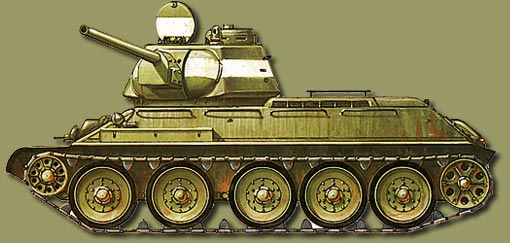
On the 4th of May, 1938 the Ministry of Defense of the USSR held an extended meeting in Moscow. V.I. Molotov presided over the meeting and among those present were I.V. Stalin, K.E. Voroshilov, as well as other state and military officials, representatives of the defense industry, and tank commanders who had just recently returned from Spain. They were presented with a plan for a new light wheeled-tracked tank A-20, designed at the Kharkov Komintern steam engine factory (KhPZ). A discussion developed during the review of the project concerning the practicality of implementing wheeled-tracked drive on the tanks. The participants of the Spanish Civil War who voiced their opinions on this point, in particular A.A. Vetrov and D.G. Pavlov (at the time - head of ABTU) espoused diametrically opposing points of view on the matter. The opponents of the wheeled-tracked design, who constituted the minority, cited the unfortunate experience which involved sending BT-5 tanks to Spain, but their reasons for raising this argument were ambiguous, considering that the mentioned mission was of a very limited nature and involved only 50 BT-5 tanks. |

Unsubstantiated were also references to very low reliability ratings of this type wheeled-tracked running gear: in September of 1937, for example, while advancing to the Aragon front the BT's completed a 500-km march on paved roads without any major mechanical problems. One and a half years later, in Mongolia, BT-7 tanks of the 6th tank brigade completed an 800-km march to Halhin-Gol on tracks, also without any major problems. More likely, the point of the disagreement concerned another question: does a battle tank need this dual-purpose drive train? The wheeled drive train was primarily used during traversal of land on smooth roads and at high speeds - an opportunity, which presented itself quite rarely. If built, the drive mechanism of the A-20 would have to be even more complex than that of the BT-7 because by design the A-20 had three pairs of road wheels. The discussion brought up the vital question: was the occasional convenience of wheeled travel worth the price of a more complex drive train?

There were probably numerous manufacturing, operational, and political reasons against the complex design, but if the bosses wanted a wheeled-tracked tank, why argue? In the end, unexpectedly for the many supporters of the tracked design, and not without Stalin's influence, the construction bureau of KhPZ was entrusted with designing a tracked tank, analogous in mass and tactical/technical characteristics (except of course for the running gear) to the A-20. The decision concerning the drive system was going to be finalized after comparative field testing of the prototypes. Here, it would be appropriate to deviate from our discourse and take a look into the history of development of A-20 to remind the reader of a few significant facts, because it was none other than the A-20 that became the precursor of the tank which would later come to be know as T-34. In 1937, Factory #183 (KhPZ received this number in the second half of the year) in accordance with the tactical-technical characteristics required by ABTU, was given the task of designing wheeled-tracked tanks BT-7IS and BT-9, as well as making preparations to produce 100 BT-7IS's in the same year. This work was hindered by the construction bureau KB-190, department "100" (tank production), headed since January 1937 by M.I. Koshkin. On top of that, Koshkin in various ways deterred the work of military engineer of 3rd rank and junior scientific assistant of the Stalin VAMM, Adolf Yakovlevich Dick, who was specifically sent to KhPZ to work out several modifications of BT-IS. |
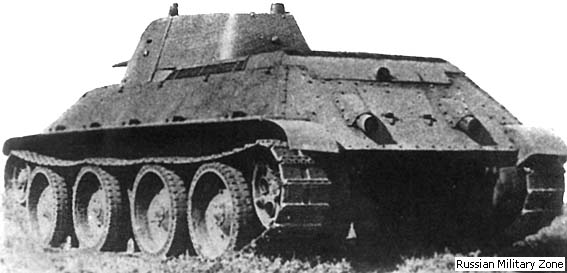
On the 13th of October 1937, ABTU stated the demand for the design of a new machine - the wheeled-tracked tank BT-20. In two weeks the director of Factory #183 Y.E. Maksarev received the following order from the Chief Directorate:
"To the director of the Factory #183.
By the Government Resolution #94 of August 15, 1937, the Chief directorate has been offered to design and create experimental versions of a high-speed wheeled-tracked tank with synchronized drive and to prepare the factory for their mass production by 1939. Considering the extreme importance of this work and tight deadlines imposed by the Government, 8th Chief directorate (Narkomat of the defense industry - Valera) deems it essential to take the following actions:
1). Create a separate construction bureau (OKB) at KhPZ, which will be under direct supervision of the head engineer of the factory.
2). In accordance with VAMM and ABTU, appointed A.Dick, military engineer of 3rd rank and junior scientific assistant of the academy as the supervisor of this bureau and appoint a team of 30 VAMM graduates for work in the bureau starting on the 5th of October with 20 more persons being added by the 1st of December.
3). In accordance with ABTU RKKA appoint Captain Evgenij Anatolievich Kulchitsky as the head consultant for the new machine.
4). No later than by the 30th of September, select for work in OKB the 8 best tank constructors at the factory so that they can be appointed as supervisors of individual groups, as well as a standards official, a secretary, and a record keeper.
5). Create a mock-up shop in the OKB and ensure the right of first priority for all work connected with the new development in all the shops of the factory.
6). Recognize the crucial necessity to design three versions of the running gear and build two experimental examples, as affirmed in the review of the projects.
7). Conclude an agreement with ABTU to conduct the work no later than by the 15th of October, 1937."
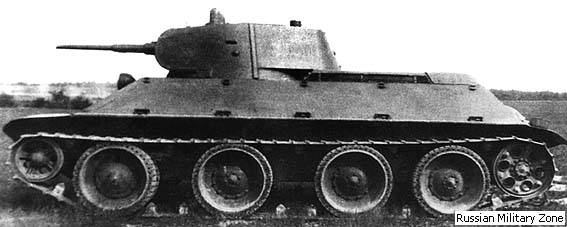
As a result, the newly created design bureau was much more powerful than the main KB. For the development of the new tank ABTU sent to Kharkov captain E. A. Kulchitski, military engineer of 3rd rank A.Y. Dick, engineers P.P. Vasiliev, V.G. Matyukhin, Vodopianov, and 41 VAMM graduates. In its turn the factory selected constructors A.A. Morozov, N.S. Korotchenko, Shur, A.A. Moloshtanov, M.M. Lurie, Verkhovskii, Dikon, P.N. Goryun, M.I. Tarshinov, A.S. Bondarenko, Y.I. Baran, V.Y. Kurasov, V.M. Doroshenko, Gorbenko, Efimov, Efremenko, Raidochin, P.S. Sentyurin, Dolgonogov, Pomochaibenko, V.S. Kalendin, and Valovoi. The supervisor of the OKB was appointed to be A.Y. Dick, the assistant supervisor - engineer P.N. Goryun, consultant of ABTU - E.A. Kulchitskii, section supervisors - V.M. Doroshenko (control), M.I. Tarshinov (hull), Gorbenko (power plant), A.A. Morozov (transmission), and P. P. Vasiliev (drive train).
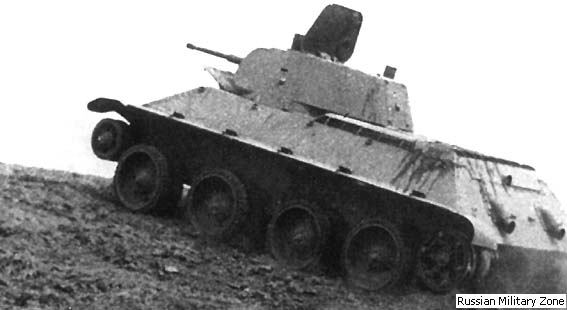
All information about the work of this team that has been discovered so far, ends abruptly at the beginning of November 1937. However, it is positively known that TTT for the tank BT-20 (factory index - A-20) in many ways were based on the design concepts of A.Y. Dick, created in the summer of 1937. Primarily this concerns the construction of gear train, inclination angles of the upper parts of the hull sides, longitudinal placing of propeller shafts in the chassis, angled placement of springs, etc. Even Dick's idea of using five pairs of drive wheels in order to better distribute the load on the chassis found practical application on later machines (however, not on the A-20).

The published materials about the history of development of T-34 do not talk about OKB, but only mention a section or bureau of perspective development headed by A.A. Morozov, essentially with the same personnel. In the album "Kharkov construction bureau for machine-building of the name of A.A. Morozov," published in Kharkov for the 70th anniversary of KB, it is mentioned that in order to complete the task of developing a new wheeled-tracked tank M. I. Koshkin organized a new subdivision - KB-24. He personally picked the constructors from the volunteers of KB-190 and KB-35 (the latter was responsible for managing the mass production of the heavy tank T-35. - Valera). This team included 21 people: M. I. Koshkin, A. A. Morozov, A. A. Moloshtanov, M. I. Tarshinov, V. G. Matyukhin, P. P. Vasiliev, C. M. Braginskii, Y. I. Baran, M. I. Kotov, Y. S. Mironov, V. S. Kalendin, V. E. Moiseenko, A. I. Shpaihler, P. S. Sentyurin, N. S. Korotchenko, E. S. Rubinovich, M. M. Lurie, G. P. Fomenko, A. I. Astahov, A. I. Guzeeva, and L. A. Bleimshmidt. At the above-mentioned meeting of the Ministry of Defense the A-20 project was presented by M. I. Koshkin and A. A. Morozov. But let's return back to 1938. |

The technical development of a tracked tank, designated A-32, did not take long because its appearance was identical to that of A-20, except for the running gear, which had 5 drive wheels on each side (not 4, like on the A-20). In August 1938 both projects were presented at the meeting of the Chief Military Council of RKKA at the Ministry of Defense. The general opinion of the participants was again leaning toward the wheeled-tracked tank. Once again, Stalin's opinion was the deciding factor: he suggested to build and test both tanks and then make the final decision. The urgency of drawing up the blueprints prompted the expansion of the design team. In the beginning of 1939, the three design teams at Factory #183 - KB-190, KB-35, and KB-24 - were united into a single entity, code named - division 520. At the same time all of the research shops at the factory were also merged. M. I. Koshkin became the head designer of division 520, A. A. Morozov became the supervisor of the KB and deputy head constructor, and N. A. Kucherenko became deputy supervisor. By the May of 1939, trial versions of the new tanks were produced in metal. Before July both machines were undergoing factory tests in Kharkov, and between 17th of July and 23rd of August they underwent field tests. In the test report it was pointed out that neither machine had the full inventory of mandatory equipment. This especially concerned the A-32, which lacked OPBT instrumentation; 6 of the 10 drive wheels were borrowed from BT-7 and battle stowage was not properly furnished.
The commission responsible for conducting the tests made the following comments on the difference between the A-32 and A-20: the former does not have wheeled drive, its hull armor is 30 mm thick (instead of A-20's 25 mm), the main gun is a 76-mm L-10 instead of a 45-mm, its mass is 19 tons. Ammunition storage in the front and on the sides of the A-32 was configured for 76-mm shells. Because of the absence of wheeled drive and the presence of 5 drive wheels, the inner part of the A-32's hull was slightly different from that of A-20. In other respects, there were no major differences between the two tanks. TTH (technical/tactical characteristics) of both tanks were adjusted during the tests. In the course of factory testing A-20 traveled 872 km (655 km on tracks, 217 km on wheels) and A-32 - 235 km. During the field tests A-20 traveled 3267 km (2176 km on tracks), A-32 - 2886 km. The head of the commission colonel V. N. Chernyaev hesitated to pick either machine as a winner and concluded that both tanks passed the testing successfully. This again raised the earlier question. On the 23rd of September 1939 there took place a tank show, conducted for the Red Army command. Among those present were K.E. Voroshilov, A.A. Zhdanov, A.I. Mikoyan, N.A. Voznesenskii, D.G. Pavlov, and others, as well as the chief designers of the tanks. |
Besides the A-20 and the A-32, heavy tanks KV, SMK and T-100 and light tanks BT-7M and T-26 were also brought to the proving grounds. The performance of the A-32 was quite commendable. With seeming effortlessness, the tank surmounted a trench, escarpment, counterescarpment, track bridge, forded a river, climbed a 30° incline and finally, to the great delight of the spectators, toppled a large pine tree with the front section of the hull. From to the results of the tests and the demonstration it was suggested that since the A-32 could potentially support a larger weight, the armor should be increased to 45 mm, with all the supporting parts reinforced appropriately. In fact, two of such tanks were already being produced at the shop of Factory #183, under the factory index A-34. Simultaneously, in October-November of 1939 test were being conducted with two A-32 whose mass has been increased to 6830 kg, equal to that of A-34. The factory was in a hurry to build the new tanks in time for the 7th of November and employed all of its resources to achieve this goal. However, technical difficulties with power units and transmissions slowed down the production. Despite this delay, all assembly was still made very carefully, all threaded joints were treated with hot oil, and all friction surfaces were wetted through with distilled lubricating grease. Ignoring the protests of military representatives the transmissions were assembled exclusively with imported bearings. Both inner and outer surfaces of the hull and turrets were subject to comprehensive finish. The rather complex technology involved in the production of armored parts for the two tanks did not contribute to faster production either. In particular, the forward section of the hull was fabricated from a single armor plate, which first had to be tempered, then formed, and tempered again. During the tempering and hardening process the parts got damaged and cracks formed during forming. The substantial size of the parts made them difficult to handle during improvement of mistakes. |
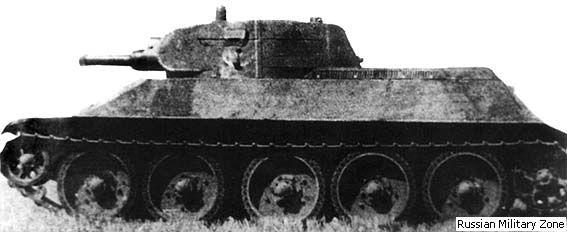
The turret was also welded from large bent armor plates. The openings (for example, the embrasure of the gun) were cut out after forming, which caused great difficulties during the fabrication. At the same time, by the decree of the Ministry of Defense of SNK USSR #443ss, the A-34 tank was recommended to be accept for service under the designation T-34 "in case it will successfully pass a 2000-km race".
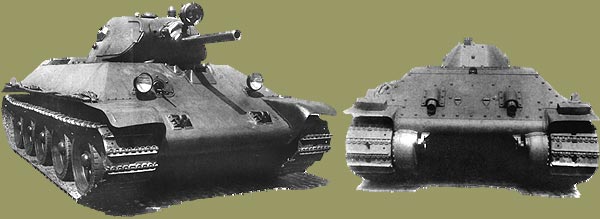
The production of the first A-34 was completed in January 1940; that of the second one - in February. Army tests started immediately and were documented in official evaluations:
"The first A-34 vehicle passed 200 km of testing. Off-road capability is good. The accompanying BT often got stuck and had to be rescued by the A-34. However, visibility is terrible. The glass fogs up and gets covered by snow within 7-10 minutes. Further progress is impossible - the windows have to be cleaned from the outside. The turret is cramped. 02/15/40. We returned from the run. The tank was taken to have the mask installed. The second A-34 - conducted the break in, all mechanisms are working normally."
After the 250 km run, the first A-34 suffered from a malfunctioning engine, with only 25 hours of operation, which had to be replaced. By February 26th this machine had traveled only 650 km, and the second one - only 350. It became obvious that it will be impossible to conclude all of the testing - 2000 km worth - before the government showing, scheduled for March, and without the completion of the testing, the tanks could not take part in the demonstration. That's when it was decided to drive both A-34s from Kharkov to Moscow, thus accruing the needed mileage in the process. At the special meeting of the party committee of the factory, M.I.Koshkin was appointed as the person responsible for the task. On the morning of March 5th (according to other sources, on the night of March 5th-6th), a procession of two A-34s and two tractors "Voroshilovets," one of which was outfitted as living quarters and the other - fully stocked with spare parts, started out down the road to Moscow. To keep the journey secret, the rout circumvented all major towns and roads. The use of bridges was permitted only if it was impossible to cross a river by ice at night. The schedule of the journey took into account not just the time needed for travel and rest, but also the schedule of trains at railway intersections and the predicted weather conditions along the route. The average speed had to be no greater than 30 km/hour. Unfortunately, trouble started fairly soon, not far from Belgorod. While traversing a snow field, one of the tanks lost its main friction clutch. In a number of publications this is attributed to the inexperience of one of the drivers. |
However, this seems unlikely because the driving was entrusted to the best test drivers at the factory, with hundreds of kilometers of experience. Y.E. Maksarev offers a different explanation in his memoirs. According to him, "a representative of GABTU got behind the controls and started turning the machine on snow at full speed, which caused the malfunction of the main friction clutch." M.I. Koshkin decided to continue the journey with just one tank and to have a repair team from the factory fix the other one. In Serpukhov, the vehicles were met by the deputy people's commissar of intermediate machine production A.A. Goreglyad (in 1939 control of all tank factories was given over from Narkomoboronprom to Narkomsredmash). The working tank arrived in the suburbs of Moscow at the Factory #37, located in Chergizov. During the next several days, until the second tank had not arrived, the factory was visited by representatives from NTK GABTU, VAMM, and Chief Headquarters of RKKA - all of whom wanted a peek at the new machine. During one of these days, M.I. Koshkin became ill and had a fever - the cold weather on the trip took its toll. On the night of March 17th both "34s" arrived at the Ivanov square in the Kremlin. Besides M.I. Koshkin, only two other workers of Factory #183 were admitted into the Kremlin. |

Driver of the tank #1 was N.F. Nosik, and that of #2 - I.G. Bitenskii (according to other sources - V. Dyukanov). Next to them, in the position of the gunner sat employees of NKVD. In the morning, the tanks were approached by a large group of party and government officials - I.V. Stalin, V.M. Molotov, M.I. Kalinin, L.P. Beriya, K.E. Voroshilov and others. The head of GABTU D.G. Pavlov gave the report. After him spoke M.I. Koshkin. Despite the medicine that he took, Koshkin could not restrain himself from coughing, which prompted disapproving glances from I.V. Stalin and L.P. Beriya.

After the report and the inspection, the two tanks drove off in opposite directions: one - to the Spasskie gates, the other - to Troitskie. Before reaching the gates, they turned around sharply and headed toward each other, sending sparks from under the tracks. After completing several laps and turns, the tanks stopped back in the starting position. Stalin liked the new machines and ordered that Factory #183 receive all the necessary assistance to eradicate the minor faults of A-34, which were explicitly pointed out to him by the deputies of people's commissar of defense, G.I. Kulik and D.G. Pavlov. The latter boldly said to Stalin: "We will pay a big price if our vehicles are not battle worthy enough."
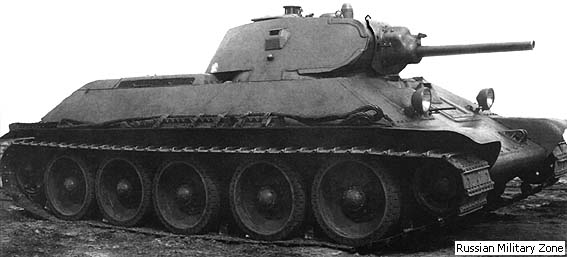
After the Kremlin inspection the tanks headed to the Kubinka proving grounds where they were subjected to 45-mm gun fire. After that, the machines moved on, taking the route Minsk-Kiev-Kharkov. On March 31st 1940, the Defense Ministry signed a protocol which ordered the mass production of T-34(A-34) at the Factory #183 and STZ with a significant stipulation "if the A-34 will pass all army tests". Upon their arrival in Kharkov after the 3000 km run, a number of defects was found in the tanks: there was burned ferrodo on the main friction clutch disks, cracked blowers, fractured transmission gears, burned out brakes. The KB was working to fix these defects, but everybody knew that even after modifications the A-34 would not be able to successfully complete the 3000 km guarantied under the warranty. Nevertheless, the plant adopted a mass production program for 1940, which specified the production of 150 A-34 tanks.
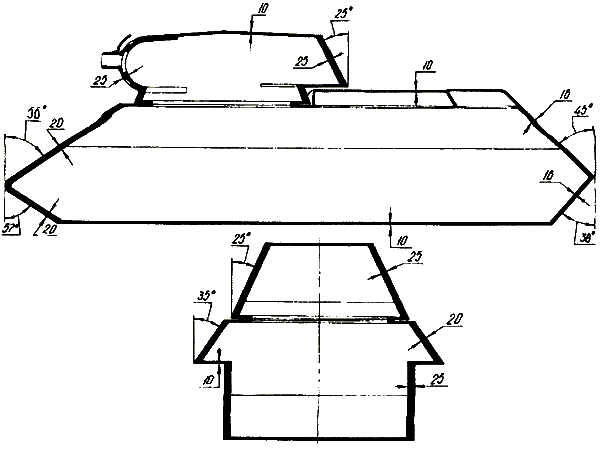
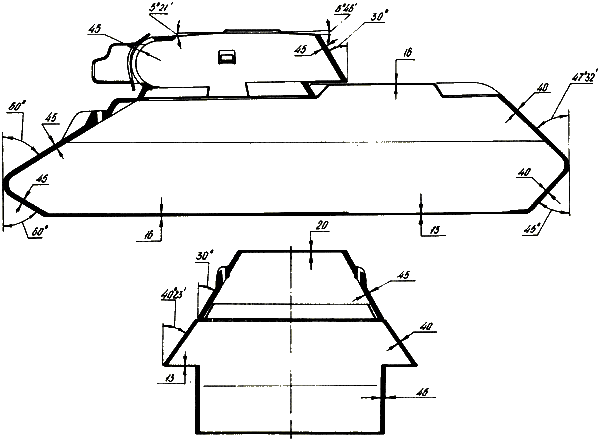
| REFERENCES: Specification of Soviet tanks Specifications of Soviet tank guns |
Translation:
Leonid Sapronov Sources: M.Pavlov, I.Pavlov, I.Zheltov "Sovetskie Srednie Tanki Dovoennogo Perioda", Armada, 2000: "Srednij tank T-34. Albom konstruktivnikh elementov", NKTP, 1941; "T-34. Obsluzhivanie", NKTP, 1941; "T-34. Rukovodstvo po ispol'zovaniu", Voenizdat, 1941; Bronekollektsiya #3, 1999; I.Shmelev "T-34", Tekhnika i Vooruzhenie #11-12, 1998; S.Zaloga, J.Grandsen "T-34 in action". |